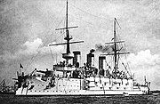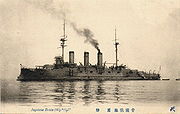
Japanese battleship Suwo
Encyclopedia
Pobeda , was one of eight Russia
Russia
Russia or , officially known as both Russia and the Russian Federation , is a country in northern Eurasia. It is a federal semi-presidential republic, comprising 83 federal subjects...
n pre-dreadnought
Pre-dreadnought
Pre-dreadnought battleship is the general term for all of the types of sea-going battleships built between the mid-1890s and 1905. Pre-dreadnoughts replaced the ironclad warships of the 1870s and 1880s...
battleship
Battleship
A battleship is a large armored warship with a main battery consisting of heavy caliber guns. Battleships were larger, better armed and armored than cruisers and destroyers. As the largest armed ships in a fleet, battleships were used to attain command of the sea and represented the apex of a...
s captured by the Imperial Japanese Navy
Imperial Japanese Navy
The Imperial Japanese Navy was the navy of the Empire of Japan from 1869 until 1947, when it was dissolved following Japan's constitutional renunciation of the use of force as a means of settling international disputes...
during the Russo-Japanese War
Russo-Japanese War
The Russo-Japanese War was "the first great war of the 20th century." It grew out of rival imperial ambitions of the Russian Empire and Japanese Empire over Manchuria and Korea...
of 1904–1905. She was sunk during the war, and then salvaged afterwards by the Japanese and placed into service under the name .
Russian career
Pobeda was built as one of three battleshipBattleship
A battleship is a large armored warship with a main battery consisting of heavy caliber guns. Battleships were larger, better armed and armored than cruisers and destroyers. As the largest armed ships in a fleet, battleships were used to attain command of the sea and represented the apex of a...
s and commissioned into the Imperial Russian Navy
Imperial Russian Navy
The Imperial Russian Navy refers to the Tsarist fleets prior to the February Revolution.-First Romanovs:Under Tsar Mikhail Feodorovich, construction of the first three-masted ship, actually built within Russia, was completed in 1636. It was built in Balakhna by Danish shipbuilders from Holstein...
in 1903. She was one of Russia's first ships to mount quick-firing guns. She had a high forecastle
Forecastle
Forecastle refers to the upper deck of a sailing ship forward of the foremast, or the forward part of a ship with the sailors' living quarters...
and secondary guns mounted on two decks, and armor that stretched the entire length of the hull.
The Peresvet design inspired by the British
Royal Navy
The Royal Navy is the naval warfare service branch of the British Armed Forces. Founded in the 16th century, it is the oldest service branch and is known as the Senior Service...
battleship , and was designed as essentially an enlarged armoured cruisers, with good range and seakeeping
Seakeeping
Seakeeping ability is a measure of how well-suited a watercraft is to conditions when underway. A ship or boat which has good seakeeping ability is said to be very seaworthy and is able to operate effectively even in high sea states....
, with higher speed but weaker armour and armament than contemporary first class battleships.
After trials, both of her sister ships were transferred to Port Arthur as part of the Russian Pacific Fleet. Pobeda was damaged first by gunfire off Port Arthur, then by a mine
Naval mine
A naval mine is a self-contained explosive device placed in water to destroy surface ships or submarines. Unlike depth charges, mines are deposited and left to wait until they are triggered by the approach of, or contact with, an enemy vessel...
. She took eleven hits at the Battle of the Yellow Sea
Battle of the Yellow Sea
The Battle of the Yellow Sea was a major naval engagement of the Russo-Japanese War, fought on 10 August 1904. In the Russian Navy, it was referred to as the Battle of 10 August. The battle foiled an attempt by the Russian fleet at Port Arthur to break out and form up with counterparts from...
, and while back at Port Arthur for repairs she was repeatedly hit by Japanese shore batteries during the Siege of Port Arthur
Siege of Port Arthur
The Siege of Port Arthur , 1 August 1904 – 2 January 1905, the deep-water port and Russian naval base at the tip of the Liaotung Peninsula in Manchuria, was the longest and most violent land battle of the Russo-Japanese War....
. On 7 December 1904, Japanese siege guns finally sank the vessel. Her sister ship
Sister ship
A sister ship is a ship of the same class as, or of virtually identical design to, another ship. Such vessels share a near-identical hull and superstructure layout, similar displacement, and roughly comparable features and equipment...
was likewise also lost at Port Arthur, and her other sister ship was sunk at the Battle of Tsushima
Battle of Tsushima
The Battle of Tsushima , commonly known as the “Sea of Japan Naval Battle” in Japan and the “Battle of Tsushima Strait”, was the major naval battle fought between Russia and Japan during the Russo-Japanese War...
.
Japanese career
Salvaged by Japanese engineers after the war in October 1905, she was refloated, repaired, and taken into service as the Suwo, taking her name from the ancient Japanese province Suo ProvinceSuo Province
was a province of Japan in the area that is today the eastern part of Yamaguchi Prefecture. It was sometimes called . Suō bordered on Aki, Iwami, and Nagato Provinces....
, now part of Yamaguchi Prefecture
Yamaguchi Prefecture
is a prefecture of Japan in the Chūgoku region on Honshū island. The capital is the city of Yamaguchi, in the center of the prefecture. The largest city, however, is Shimonoseki.- History :...
.
After reconstruction at Yokosuka Naval Arsenal
Yokosuka Naval Arsenal
was one of four principal naval shipyards owned and operated by the Imperial Japanese Navy, and was located at Yokosuka city, Kanagawa prefecture on Tokyo Bay, south of Yokohama...
with Japanese boilers and guns, Suwo was re-designated as a 1st class coastal defence ship
Coastal defence ship
Coastal defence ships were warships built for the purpose of coastal defence, mostly during the period from 1860 to 1920. They were small, often cruiser-sized warships that sacrificed speed and range for armour and armament...
in October 1908. She served in this role for many years, and received a refit in 1912. In World War I
World War I
World War I , which was predominantly called the World War or the Great War from its occurrence until 1939, and the First World War or World War I thereafter, was a major war centred in Europe that began on 28 July 1914 and lasted until 11 November 1918...
, during the Battle of Tsingtao
Battle of Tsingtao
The Siege of Tsingtao was the attack on the German-controlled port of Tsingtao in China during World War I by Imperial Japan and the United Kingdom....
from 27 August 1914, serving as flagship
Flagship
A flagship is a vessel used by the commanding officer of a group of naval ships, reflecting the custom of its commander, characteristically a flag officer, flying a distinguishing flag...
for the Imperial Japanese Navy squadron under Vice-Admiral Kato Sadakichi, to blockade the coast of German
German Empire
The German Empire refers to Germany during the "Second Reich" period from the unification of Germany and proclamation of Wilhelm I as German Emperor on 18 January 1871, to 1918, when it became a federal republic after defeat in World War I and the abdication of the Emperor, Wilhelm II.The German...
-controlled Kiaochow. The British Royal Navy
Royal Navy
The Royal Navy is the naval warfare service branch of the British Armed Forces. Founded in the 16th century, it is the oldest service branch and is known as the Senior Service...
attached the China Station
China Station
The China Station was a historical formation of the British Royal Navy. It was formally the units and establishments responsible to the Commander-in-Chief, China....
's pre-dreadnought and the destroyer
Destroyer
In naval terminology, a destroyer is a fast and maneuverable yet long-endurance warship intended to escort larger vessels in a fleet, convoy or battle group and defend them against smaller, powerful, short-range attackers. Destroyers, originally called torpedo-boat destroyers in 1892, evolved from...
to the Japanese squadron, which consisted of mostly obsolete warships, and several modern ones including the seaplane carrier , dreadnought
Dreadnought
The dreadnought was the predominant type of 20th-century battleship. The first of the kind, the Royal Navy's had such an impact when launched in 1906 that similar battleships built after her were referred to as "dreadnoughts", and earlier battleships became known as pre-dreadnoughts...
s and , and the battlecruiser
Battlecruiser
Battlecruisers were large capital ships built in the first half of the 20th century. They were developed in the first decade of the century as the successor to the armoured cruiser, but their evolution was more closely linked to that of the dreadnought battleship...
for this operation.
After the end of World War I, Suwo was assigned to training for cadets and engineers. She became a gunnery training ship in 1917. In 1922, as one of the results of the Washington Naval Treaty
Washington Naval Treaty
The Washington Naval Treaty, also known as the Five-Power Treaty, was an attempt to cap and limit, and "prevent 'further' costly escalation" of the naval arms race that had begun after World War I between various International powers, each of which had significant naval fleets. The treaty was...
, Suwo was disarmed at Kure Naval Arsenal
Kure Naval Arsenal
was one of four principal naval shipyards owned and operated by the Imperial Japanese Navy. -History:The Kure Naval District was established at Kure, Hiroshima in 1889, as the second of the naval districts responsible for the defense of the Japanese home islands along with the establishment of the...
. During this process, on 13 July, the old vessel capsized. The hull was righted and the turrets, machinery, and main armor removed, but work stopped there. The hull was towed to Mitsugojima, were it remained throughout the Pacific War
Pacific War
The Pacific War, also sometimes called the Asia-Pacific War refers broadly to the parts of World War II that took place in the Pacific Ocean, its islands, and in East Asia, then called the Far East...
as a storage hulk. In 1946, the hulk was towed back to Kure
Kure, Hiroshima
is a city in Hiroshima prefecture, Japan.As of October 1, 2010, the city has an estimated population of 240,820 and a population density of 681 persons per km². The total area is 353.74 km².- History :...
and broken up for scrap.


